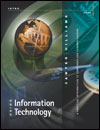Click-Along 1-1 UNDERSTANDING YOUR PERSONAL MULTITASKING: How Many Tasks Do You Juggle at Once While You're Studying? The authors of USING INFORMATION TECHNOLOGY want students not only to learn about computers and communications but also to learn how to learn, because you will need it not only to get through the course but also to get through the rest of your life and professional career. That's why we have Key Questions at the beginning of each section and Concept Checks throughout. That's why at the end of every chapter there's a distinctive Summary (telling you what a term or concept means and why it's important) and a Chapter Review featuring a three-stage learning methodology. And it's also why we offer a positive, learning-centered variation on what is known as multitasking. Does Your Multitasking Actually Impede Learning? "Multitasking" describes a computer's ability to run several programs at once. It's also the name for the kind of behavior in which people perform several tasks seemingly at once-for instance, try to study AND eat AND watch television AND talk on the phone. AND maybe check e-mail and some websites, too. Is this the kind of thing you do? Certainly it's a regular activity for a lot of students. Teenagers and twenty-somethings especially excel at it, perhaps juggling a half dozen activities simultaneously compared to perhaps only two or three among older students. The problem with doing multitasking while doing homework, experts say, is that it defeats the purpose of studying, which is to learn and retain information. The Journal of Experimental Psychology reported that people lose time and concentration when switching between tasks. This is because the brain really doesn't do multitasking-process several kinds of information at once. Rather it does task switching-it performs actions one task at a time in linear sequence. Thus, you need to know how to prioritize the several tasks you're working on. As one writer said, "To know when to switch tasks, you must distinguish between the tasks you must perform and those you can afford to blow off." The Opposite of Casual Multitasking: Overlearning & Depth of Processing How well could you play a part in a play or a movie after two readings? five readings? fifteen? Clearly, you can't just speed-read or skim the script. You have to actively practice or rehearse the material. The more you rehearse, the better you retain information. Indeed, it has been found that overlearning-continued study even after you think you have learned material-will help you really commit it to memory. Overlearning is defined as continued rehearsal of material after you first appear to have mastered it. And the more you rehearse, the better you may also understand material. Information may also be stored at a superficial level or at a deep level, depending on how well you understand it and how much you think about it, according the depth-of-processing principle, which states that how shallowly or deeply you hold a thought depends on how much you think about it and how many associations you form with it. The deeper the level of "processing" or thinking, the more you remember it. This means that in memorizing something you shouldn't just mindlessly repeat the material; you are better able to remember it when you can make it meaningful. It's important to somehow make the material your own-understand it, organize it, and put it in your own words, develop emotional associations toward it, link it with information you already know or events you have already experienced. The Website "Click-Alongs": Using the Built-in Multitasking Feature of This Book to Your Benefit This book offers a distinctive feature not found with other texts-namely, harnessing multitasking to support your motivation and learning goals. If you have access to an Internet-connected computer while reading this text, every time you see the mouse logo in the margin of the book you can go to this website and use your mouse to "click along" while reading the text. The Click-Along will lead you to examples, updates, elaboration, more practical advice, and access to additional resources on the Student Online Learning Center. By making the effort to link to and read the additional information, you will help to make the learning experience practical and more personally meaningful to you. With every such personal engagement, you will be better able to memorize and retain the material. And thus better able to call it to mind on quizzes and tests. The payoff: More personal involvement in learning will lead to better test results and better grades. | 



 2002 McGraw-Hill Higher Education
2002 McGraw-Hill Higher Education